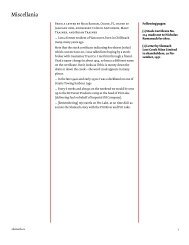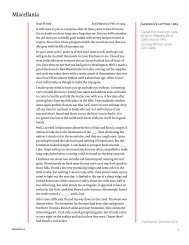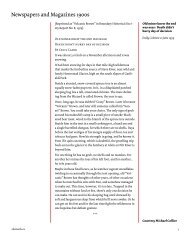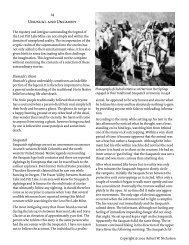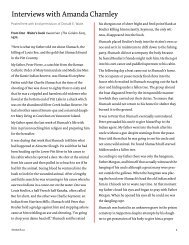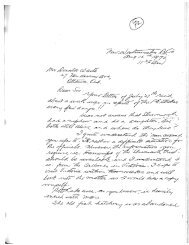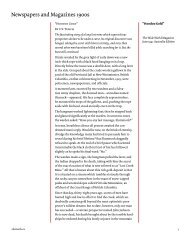first to discover Pitt Lake Glacier, Sun 28 August 1926. - Slumach
first to discover Pitt Lake Glacier, Sun 28 August 1926. - Slumach
first to discover Pitt Lake Glacier, Sun 28 August 1926. - Slumach
You also want an ePaper? Increase the reach of your titles
YUMPU automatically turns print PDFs into web optimized ePapers that Google loves.
Newspapers and Magazines 1900s<br />
“Lone Prospec<strong>to</strong>r” <strong>first</strong> <strong>to</strong> <strong>discover</strong> <strong>Pitt</strong> <strong>Lake</strong> <strong>Glacier</strong>;<br />
Stanford Corey, 77, has explored all way <strong>to</strong><br />
Artic<br />
By Laurence Donovan<br />
“Lone Prospec<strong>to</strong>r” <strong>first</strong><br />
<strong>to</strong> <strong>discover</strong> <strong>Pitt</strong> <strong>Lake</strong><br />
<strong>Glacier</strong><br />
<strong>Sun</strong> <strong>28</strong> <strong>August</strong> 1926<br />
<strong>Pitt</strong> <strong>Lake</strong> <strong>Glacier</strong>, if it may so be designated for lack of other<br />
nomenclature, hailed as a recent <strong>discover</strong>y by a party headed<br />
by George Platser, of tropical valley fame, was <strong>first</strong> <strong>discover</strong>ed<br />
26 years ago. Through the trial-less wilderness around the<br />
head of <strong>Pitt</strong> <strong>Lake</strong>, Fire <strong>Lake</strong>, the headwaters of the Stave, the<br />
Lillooet, and the <strong>Pitt</strong> rivers, a lone prospec<strong>to</strong>r, possibly the<br />
most remarkable of all the pioneer miners of British Columbia<br />
left the peculiar marks of his blaze. Somewhere in that tangle<br />
of mountain meadows, giant windfalls, rich outcropping<br />
strata of minerals and glaze ice, <strong>to</strong>day there is declared <strong>to</strong> be<br />
a cache containing <strong>to</strong>ols and a hundred pounds of powder,<br />
placed there years ago by this prospec<strong>to</strong>r. The <strong>discover</strong>y of<br />
the great glacier never was announced by this singular placer<br />
miner of the hills, for <strong>to</strong> him a glacier was just a glacier, just as<br />
the Yukon was only the Yukon when he brought the <strong>first</strong> gold<br />
from that afterwards famous terri<strong>to</strong>ry <strong>to</strong> be essayed at Vic<strong>to</strong>ria<br />
when “northern gold” was regarded as of doubtful value.<br />
__<br />
Stanford Corey, 77 years old, his luxuriant grey beard beginning<br />
<strong>to</strong> take on the colour of the myriad snow he has crossed,<br />
is going prospecting again in a few days. He is going alone.<br />
Maybe he will return in a week, or a month, or a year. It<br />
doesn’t matter. For the lone trails, that area has no trails at<br />
all, are as familiar <strong>to</strong> him as are the streets of Vancouver <strong>to</strong> a<br />
taxicab driver.<br />
The blaze marks of Stanford Corey’s axe, his own peculiar<br />
mark, are on trees northward from the Fraser River <strong>to</strong> the<br />
mouth of the MacKenzie River inside the Artic Circle. Here<br />
and there throughout the grim northland are caches of <strong>to</strong>ols<br />
and powder, some buried and forgotten, others are remembered,<br />
and one of these caches is high up <strong>to</strong>ward what may<br />
be designated as “<strong>Pitt</strong> <strong>Lake</strong> <strong>Glacier</strong>,” until a better name is<br />
applied, <strong>discover</strong>ed or re<strong>discover</strong>ed this summer as reported<br />
exclusively in the Evening <strong>Sun</strong>. For Corey on 15 different occasions<br />
crossed the Great <strong>Glacier</strong> since he <strong>first</strong> blazed a trail<br />
from the head of <strong>Pitt</strong> <strong>Lake</strong> <strong>to</strong> Howe Sound at Squamish 14<br />
years ago, at which time he <strong>to</strong>ok four months for the crossing<br />
of what is now declared <strong>to</strong> be a possible great summer playground<br />
for future <strong>to</strong>urist development.<br />
slumach.ca
Newspapers and Magazines 1900s<br />
Came here in 1867<br />
Out of the backwoods on New Brunswick Corey came <strong>to</strong> British<br />
Columbia in 1867. He became a placer miner. For 59 years<br />
he has crossed and recrossed the mountain ranges of B.C., the<br />
Yukon and northern terri<strong>to</strong>ries, his wandering blaze marks<br />
scattered throughout all of the land that is known as the “Far<br />
North.”<br />
In 1899 he spent four months crossing from the head of <strong>Pitt</strong><br />
<strong>Lake</strong> <strong>to</strong> Howe Sound. He had been <strong>to</strong> the head of Stave <strong>Lake</strong><br />
and along the <strong>Pitt</strong> River, and he had crossed the “<strong>Pitt</strong> <strong>Lake</strong><br />
<strong>Glacier</strong>” and another mountain of ice alone. Again and again<br />
he has taken that same general trail, and during all of the<br />
three score years, he says he had not seen the marks of any<br />
other person ever having entered the land. Only his own<br />
blaze marks growing dimmer and dimmer, but recognizable<br />
through the years.<br />
Minerals are there<br />
Corey, who claims <strong>to</strong> be the <strong>first</strong> prospec<strong>to</strong>r bringing gold<br />
south from the Yukon terri<strong>to</strong>ry in the early eightieth, <strong>to</strong> have<br />
it essayed at Vic<strong>to</strong>ria, because the value of northern gold was<br />
doubted in those days, says that there are outcroppings of<br />
valuable minerals in narrow stratas in the upper <strong>Pitt</strong> <strong>Lake</strong><br />
country.<br />
However, Corey does not believe there is possibility of any<br />
great strike in that region and that the only workable minerals<br />
will be subject <strong>to</strong> this kind of investment that will that<br />
will develop comparatively low-grade mines. Again, he<br />
admits some rich <strong>discover</strong>ies might be made, as much of this<br />
is a glacial country.<br />
Corey says the newly-<strong>discover</strong>ed great glacier is not extremely<br />
difficult of access.<br />
One wonderful meadow<br />
At one point, says Corey, there is a great flat at the base of<br />
the mountain where the avalanches of the years have cleared<br />
the land as cleanly as though by a giant broadaxe, and in the<br />
seasons when the snowfall is not heavy becomes a beautiful<br />
meadow. This area is between the glacier and Pember<strong>to</strong>n<br />
meadows.<br />
Over the last 50-year period, Corey believes the great glacier<br />
has remained about the same, receding in years of light<br />
<br />
slumach.ca
Newspapers and Magazines 1900s<br />
snowfalls and spreading again when the snowfall has been<br />
heavy and the summer thaw and flowage is increased. In<br />
the days when Corey <strong>first</strong> entered this region, wolves, and<br />
grizzlies abounded, he says, and it is still the haunt of many<br />
bighorns and goats.<br />
Once made his stake<br />
One Corey made his stake. Oh, maybe it was a few thousands,<br />
or a hundred thousand. It doesn’t matter. Anyway, for four<br />
years the lone prospec<strong>to</strong>r vanished from the land in which he<br />
had pioneered. In that four years he lived under 17 flags and<br />
in one country where there was no flag.<br />
“I wanted <strong>to</strong> see the world,” he explained. “For four years<br />
I travelled and studied and enlarged my views of life. And<br />
then, <strong>first</strong> thing I knew, I was carrying a 60-pound pack in the<br />
Cariboo and enjoying life again.<br />
“No. Never made much of it. You see, the season for placer<br />
mining is short and the winters have used up all I’ve panned<br />
out in the summers. Got hung up this year. Didn’t get started<br />
early enough and, besides, I am beginning <strong>to</strong> get a bit tippy.<br />
Can’t keep my balance so well walking trees across the burrows<br />
and over the canyons. Get a bit dizzy and have <strong>to</strong> be<br />
more careful.<br />
Soon going again<br />
“But I’m going <strong>to</strong> get away again in a few days now. After I<br />
had been out a few days this year I met with a little accident.<br />
Fell from a log and ran a snag through my ear. Couldn’t get it<br />
out and was several days in the bush.<br />
“It penetrated more than an inch in<strong>to</strong> my ear and I’ve been all<br />
summer getting fit <strong>to</strong> go again. But it’s all right now. Going<br />
alone? Of course. Companionship in the bush doesn’t lighten<br />
the pack any. The man who pioneers doesn’t know what it<br />
means <strong>to</strong> turn back and I tried taking someone along only<br />
twice. Both times it didn’t turn out well. They wanted <strong>to</strong> get<br />
out. So I prefer <strong>to</strong> be alone. Then I can come back when I get<br />
ready.”<br />
When in Vancouver, Corey makes his headquarters at a<br />
private home on Georgia Street East. He is a bent figure of<br />
a man, blue eyes set in a skin tanned <strong>to</strong> the colour of parchment,<br />
but his eyes are clear, steady and undimmed. Possibly<br />
he never will be immortalized in his<strong>to</strong>ry. But then, again, he<br />
may be.<br />
Note: Standford Corey died<br />
in Vancouver in the spring<br />
of 1932, 80 years old.<br />
slumach.ca



